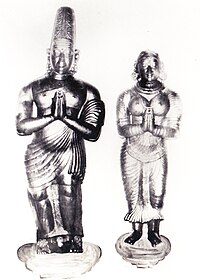Govinda Dikshita

Govinda Dikshita (Dikshitar) was the minister of three successive
About the scholar
Govinda Dikshita was a scholar, philosopher, statesman and musicologist. He was a
Legend associates him with Tirunageswaram, a village located 6 km from Kumbakonam in the Kumbakonam - Karaikal road and also with Patteswaram, 6 km south east of Kumbakonam.[4] The name of his wife is ascertained as Nagamba. But the presence of the idol of Dikshita in the premises of Patteswaram temple and presence of ruins of his house in the village outskirts confirm his private location to be Patteeswaram. His location is also believed to be Tirupalathurai, near Papanasam.[4] Life like images of Govinda Dikshithar is now worshipped at Patteswaram, with the presiding deity of Linga also called "Govinda Dikshita lingam".[4] Dikshita spent his early years in Vijayanagara kingdom where he attained his education. Dikshita is a Karnataka Brahmin of Asvalayana sutra of Rig veda.[4]
Carnatic Music
Dikshita is spoken of as 'One of the Trio of Theoreticians' of modern period; the others being Ramamatya and Somanatha. The Nayaks brought with them the glorious tradition of their country to the fertile regions of river
Govinda Dikshita was the father of another musicologist, Venkatamakhin, who is noted for his Chaturdandiprakashika, a treatise which formed the basis of the melakarta system of classification used in Carnatic music today.[6]
Construction
Dikshita is believed to have constructed the
Notes
- ISBN 9788120609969.
- ^ History of the Dvaita School of Vedanta and Its Literature: From the Earliest Beginnings to Our Own Times. B. N. K. Sharma, Motilal Banarsidass Publ., 2000.
- ^ Encyclopaedia of the Śaivism .Swami P. Anand, Swami Parmeshwaranand
- ^ a b c d N.K. 1933, pp. 1-2
- ^ Music as history in Tamilnadu. T.K. Venkatasubramanian
- ISBN 978-1-56159-263-0. Retrieved 7 September 2018.
- ^ Diaspora of the gods: modern Hindu temples in an urban middle-class world .P.246. Joanne Punzo Waghorne
- ^ Venkataramanan, Geetha (7 May 2015). "Four centuries and after". The Hindu.
- ^ http://rajavedapatasala.org/
References
- N.K., Venkatesam Pantulu (1933). Govinda Deekshita - Minister of the Tanjore Nayak kings. Rajahmundry: La;i;e Veeraraja's Andrha Vachana Bharatamu, Sabha Parvamu.
